I‘m from Earth. I like Earth, and everything concerning Earth, like sciences and myths and everything people philosophize or fantasize about. But I don’t like people.
Don't wanna be here? Send us removal request.
Text
Entirely random information, but I know some people aren’t comfortable with using the word skinwalker so in case you’re ever looking for a similar alternative word for werewolf, there’s the old Danish word skinrunner (skindløber). The name comes from the belief that the cursed person would suddenly get en uncontrollable desire to run as fast as they could, and as they cut their skin on rocks and branches it would fall off and reveal the wolf within.

Another old Danish word is marewolf (marulv) which is a specific type of werewolf and a play on the usual word varulv. These types of werewolves were the side effect of their mother crawling thought the uterus of a slaughtered horse during a full moon as a magic ritual to make the birth painless (horses were believed to have the most painless birth of all). If she had a boy he’d become a murderous werewolf and if she had a daughter she’d become a mare, one of the nightmare demons who sit on sleeping people’s chests and cause sleep paralysis and bad dreams (the Danish word for nightmare is mareridt, which literally means “mare riding”). Both werewolves and mares were normal people during the day and monsters during the night. Marewolf is of course the to words put together.

Skinrunner is probably the more attractive word but I thought I’d give you both just in case.
2K notes
·
View notes
Text

Monstober Day 10
Mosekonen brygger // The bog wife is brewing. -Danish Idiom
----
First off, thanks to @mahouwl my beloved for this one I had a GREAT time looking her up!
Mosekonen (translated to Bog Wife or Marsh Witch) is troll-like old woman in Danish folklore. She lives a hidden cabin in the marsh and brews something (no one knows exactly what) in a big kettle. Some say it's a special brew for Walpurgis Night.
Mosekonen was an explanation for the heavy mists that hung above the moor. The idea was that it was caused by the steam from her kettle, hence the expression "Mosekonen brygger" or "The bog wife is brewing" is used on days of heavy fog or mist.
She also appears in a Hans Christian Anderson tale "The Girl Who Trod on a Loaf". Let's do a quick throwback to last year, shall we?
The story has no ATU number, as it seems to be a uniquely Danish tale, without mirrors in other cultures. In it, a poor girl named Ingrid is taken in as a servant by a rich family who treats her well and buya her many nice things. She soon becomes ashamed of her poor background. One day she decides to go home, and the rich family give her a loaf of bread to give her mother. When crossing the marsh she tosses the loaf on the ground and steps on it to keep her fine shoes from getting dirty.
Her feet become stuck to the loaf and the ground opens up and drops her in the home of the mosekonen. There the devil's great-grandmother takes her for a statue and claims her to decorate the devil's great hall. She becomes a cautionary tale for other children, until one girl hears her story and feels sympathetic. The girl grows up, and on her deathbed cries for Ingrid. Ingrid feels humility at this, and is turned into a mute bird. At Christmas she collects crumbs to share with The Other birds, and when she had collected enough to equal the weight of the original loaf, she turns white and flies into the sun and disappears.
In this story, and my other research, mosekonen is positioned as a pretty neutral figure, neither good nor evil, mostly just minding her own business. There is a bit of danger though - her fire is tended by Lygtemænd (similar to will o' the wisps... more on those later), so it's ill advised to go searching for her, as you may drown.
Also huge shout out to @sinistercarnival for this Danish Folklore post, it was super helpful for this one.

14 notes
·
View notes
Text
A guide to utiseta - the Norse Vision Quest

Vikings and other ancient Norse people performed a special form of vision quest, the utiseta (literally: “sitting outside”, udesidning in danish) to get into contact with their Gods and spirits, or just to meditate and solve personal problems by thinking and experiencing nature. Traditionally, this utiseta was 3 days and nights spent in the forest, on a powerful spot, with no food or drinks. Through the sleep deprivation and abstinence, the person would more easily get in contact with Gods or natural spirits and get visions and enlightenment. Here is however a guide to a milder version of the Norse vision quest: WARNING: Don’t perform an utiseta if you have mental-health issues or a mental disorder! Speak to your therapist first. An utiseta is an extreme experience and may be a trigger! Also don’t perform an utiseta when you’re in an area with potentially dangerous wildlife! While here in my area in Denmark, the biggest predator you may meet in the forests is probably a fox, there may be wild boars or even bears in your area that you should keep yourself safe from. Also be aware if there are venomous animals! Duration: 1 night You need: Warm clothes, a special powerful place in nature, maybe a pillow to sit on, maybe an little instrument for the starting ritual, and maybe an offering for the spirits at the end. Phones, lights (like torches) and watches are not allowed. Let‘s go:
On beforehand, find a place in nature that you feel safe. Traditionally the utiseta was performed in the forest, sitting at a tree. But it may not necessarily be a spot in the forest (though this will give you the strongest experience), but maybe on a clearing, on a field, on the beach or even in your backyard. The more natural the better, but it’s always best to do it in a place you really feel safe. This is your special place of power.
Traditionally you should not eat or drink on the day before, but it is not necessary, if you eg. don’t have any experience with abstinence or fasting. When you’re out on the utiseta, you should however do without food or drinks.
If it’s your first utiseta it may be a good idea to choose a night with a full moon, as the total darkness may be more frightening. Human night vision may be better than you may expect first, but the moonlight still makes a huge difference! Also choose a night in the warm seasons, so you don’t freeze (remember to dress warm and according to the weather though, and it’s a good idea to use insect repellent), and if your location allows it, eg. sometime in summer when the nights are shorter.
Go to your place of power before sundown. Get comfortable (but not so comfortable that you fall asleep). Pillows are allowed, but no chairs or similar - the intention is to be connected to the Earth while getting in touch with her spirits.
At sundown, the utiseta is traditionally started with a little ritual. This could be a little prayer, song or dance, or you could even bring a little drum, bell or rattle. Whatever you feel like.
When the sun is down, just try to stay calm and breathe. It’s usually a frightening experience, especially in the first hours. The nightlife awakens and may seem much more comprehensive than day-life. It may creep you out, and you may see creatures and faces in the trees and branches - those resemble the natural spirits in past times!
Stay in your place until sunrise. It may feel like it’s never arriving, but it will, and eventually your state of mind will be relived and thus so enlightened. Traditionally you may thank the natural spirits for the night with a little offering - typically a little food like some bread, or just something from nature itself, like a pretty rock.
You can go home after the sunrise and either get some rest or start the day. Some may feel energized from their experiences, but others may feel very tired and exhausted. Listen to your body. Take your time to comprehend and arrive back in your normal course of life.
#utiseta#udesidning#vision quest#vikings#nature spirit#mythology#norse mythology#norse paganism#forestcore#witchblr
59 notes
·
View notes
Text
The Big Grey Man of Scotland
This is the urban legend of a ‘big, grey’ man, that roams the highland mountain in Scotland called, Ben Macdhui. This mountain is 4296 feet tall and not only, allegedly, homes this 'man’ but is also said to be haunted. Hikers of this area say that this large humanoid creature, with the nickname 'Fear Liath More’ (meaning 'big grey man’), stalks people who cross his mountain. Eyewitnesses say that it is 10 feet tall, very hairy with long arms and legs. So he’s a big guy.
The first known sighting of this Scottish beast was from a professor, who was exploring the misty mountain. He said, “I began to hear the sound of noises in the loose rock behind me coming down from the natural cairn on the high plateau. Every few steps I took, I heard a crunch, and then another crunch as if someone was walking after me but taking steps three or four times the length of my own.” He dismissed this as a hallucination, so he continued on his travels, but so did the steps behind him. The professor was seized with terror and fled the mountains until he reached the nearby forest. He saw nothing but was left with the image of being stalked but something inhumanly big. The professor quoted “there is something very queer about the top of Ben MacDhui.” He promised he would never roam that mountain by himself again. However, sometime later the professor received a letter from a man who detailed his own experience, he saw a giant figure approaching him, while he was trying to enjoy his hike.
This story drew in lots of media attention, so other takers of this mountain had come out with their stories. Were they just trying to follow the latest trends or did they genuinely have their own experiences with this 'big grey man’? Many people that sent in their stories, said that they felt sensations of uncontrollable fear and pain.
One story that stood out, was the story of the man who camped on top of this mountain in 1940, where he suddenly was overcome with the feeling of morbidity and the sense of unreality. Either he had taken a tab of acid or he was being watched by the 'fear liath mor’. He woke up hours later and saw something brown lurking outside his tent. He estimated it to be around 20 feet tall, with broad shoulders.
Another experience that was brought to light was from an author. She was roaming the mountains and heard a voice, she described it as having a 'gigantic resonance’ and a reminiscent of Gaelic. She hunted the grounds for any sight of civilisation but instead, she realised she was all alone, left with whomever or whatever was the owner of that voice.
Sometime in the 1990s, three mates were walking along the countryside in Aberdeen, where they spotted a dark human-shaped figure running about the fields. They felt a random, sporadic sense of terror. The three chums described the figure as “human but not-human”. One of the friends threw a stone at the figure but it disappeared into the deep, dark woods. Weeks later the same trio said they were chased by the same figure while in their car, it soon gave up and just stood and stared. Maybe this figure was trying to start a fight with the friend that launched a stone at it weeks before?
Overall, this 'big grey man’ is usually seen on the mountain or in the surrounding area. It usually gives off strong feelings of panic, distress and frightfulness to anyone that comes across it. Some people have said that they feel hypnotised or drawn to jump off dangerous ledges nearby. As well as this, ghostly laughs and eerie music has been heard in the mountains, almost like it is being carried in the wind.
So, do you think a large hairy beast lurks these lonely, desolate mountains or is it just the explorer’s wide sense of imagination?
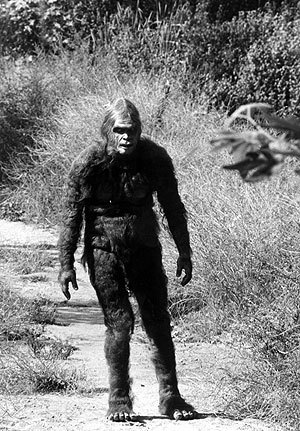
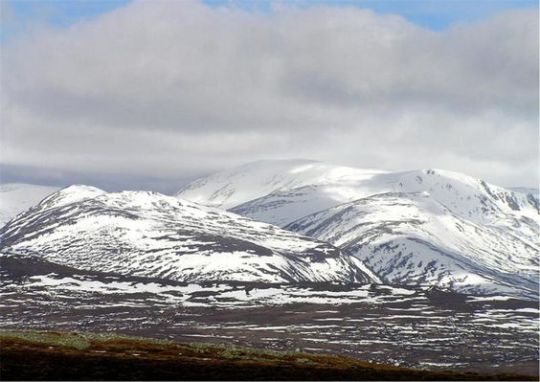
28 notes
·
View notes
Text
The Dullahan
Ireland’s own version of The Headless Horseman sometimes referred as a fairy in Irish folklore. This fairy is known as a headless rider on a black horse, carrying their head in their arm. He was said to ride fast through the counties of Down and Sligo, and if he suddenly stopped, it meant that someone in the community was due to die. The Dullahan calls out the person’s name, drawing away the soul of his victim, at which point the person immediately drops dead.
Usually, the Dullahan is male, but there are some female versions. It is said to be the embodiment of the Celtic God From Dubh, “King Idol of Ireland”. The mouth is usually in a hideous grin that touches both sides of the head. Its eyes are constantly moving about and can see across the countryside even during the darkest nights. The flesh of the head is said to have the color and consistency of moldy cheese. The Dullahan is believed to use the spine of a human corse as a whip. It’s wagon/carriage adorned with candles in skulls to light the way, thigh bones make the spokes of its wheels and the wagon’s covering is made of dried human skin. There are rumors that golden objects can force the Dullahan to disappear.
So if you’re ever unfortunate to run into The Dullahan out in the dark countrysides of Down and Sligo make sure you have some gold to protect yourself and your soul from the dreaded headless horseman.
107 notes
·
View notes
Photo
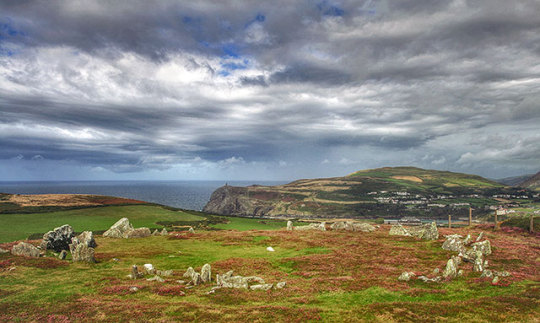


Haunted Meayll Hill Stone Circle, Isle of Man
Meayll Hill (Mull Hill) is not a true stone circle, but a unique group of Neolithic chambered tombs built around 3500 BC. These tombs are characteristic for Neolithic farmers in the British Isles, but the arrangement of 12 of them in ring formation is very unusual and no one knows why they were arranged this way. A group of stone foundations of Neolithic huts can be found nearby to the east with an ancient pathway running between the two sites.
According to local lore, some visitors have had unpleasant paranormal experiences at Meayll Hill, including the feeling of sudden disorientation. Others have seen unexplained moving lights and heard strange sounds, like the cadence of invisible horses trotting or galloping by. One tale says that a phantom army of horsemen has been seen riding along the circle.
The site is located just outside the village of Cregneash at the southern end of the Isle of Man, in the Irish Sea between England and Ireland.
Click here to aerial video of Meayll Hill.
1K notes
·
View notes
Text
The Thrumpin:
Faery Reapers of the Scottish Borderlands
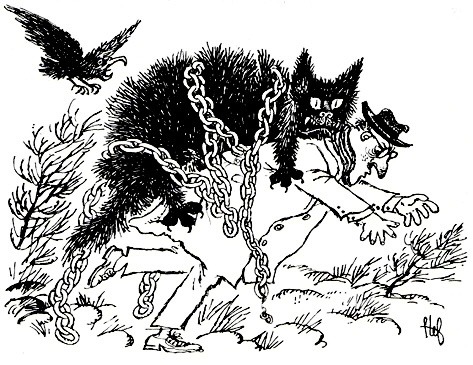
One creature that I find particularly interesting, and which I thought would be worth talking about a little bit here, is an obscure faery spoken of in the folklore of the Scottish Borderlands; the Thrumpin. Very little is known about this creature, as there are only a couple of known historical references to the creature, but it could be simplistically described as a dark inversion of the Guardian Angel. Indeed, the name of this faery likely originates from the Scots word Thrump, meaning ‘to push or jostle,’ which is possibly a reference to the fact that the Thrumpin is an otherworldly force responsible for pushing mortals forward along the path to their ultimate fate.
Thrumpins were said to act as attendant spirits of human fate, with one Thrumpin assigned to every person upon their birth. As such, each of them possesses the power to end the life of the individual they oversee. The reason these faeries were said to act in this capacity remains a mystery, as does the ultimate power behind their assignment in this world, but certain theories do exist as to the nature of the circumstances that lend themselves to a Thrumpin successfully stealing away the life of its charge. Most of what can be gleaned about the matter comes from a single set of rhyming verses, the origins of which aren’t entirely clear, but seem to represent a gathering of oral folk traditions documented within folklorist Thomas Wilkie’s (1789-1838) essay ‘Old Rites, Ceremonies, and Customs of the Inhabitants of the Southern Counties of Scotland’ which was posthumously published in ‘History of the Berwickshire Naturalist Club, VOL. XXIII’ (1916.) The verses are transcribed as follows:
“When the hullers o' night are loorin',
When the quakens are crimplin' eerie,
When the moon is in the latter fa',
When the oolets are scraughan' drearie,
When the ellere'ed are clumperin'
And the toweries hard are thumpin',
When the bauckie-bird he kisses the yird,
Then, then's the time for thrumpin'.
And gif ye miss the mistic hour,
When spirits have been raised by invokerie,
To thrump ilk faithless wight;
The heavens will gloom like a wizard's smile,
And the foumart will dern his carcase vile,
From all uncannie sight.
For man and beast, by the three sterns' light,
Have little chance to shrive;
Till the sixty are past, and not till the last,
Can man and beast survive.”
To the best of my knowledge, there is no known analyzation of the folk-rhyme cited by Wilkie, and so, though I am far from being an authority on 18th century Scots, or on Scottish folklore in general, I managed to construct my own rendering of the verses into modern English using various Scots dictionaries and preexisting contextual clues. It seems to check out, after plenty of double-checking, but I encourage anyone who may know more than me about these subjects to come forward with corrections or additional information. Based on my translations, it can be rendered as:
‘When the mists of night are clearing,
When the poplars are eerily rustling,
When the moon is below the horizon,
When owlets are screeching drearily,
When the Elder trees are galumphing,
When the Powries* are loudly thumping,
When the bat swoops low to the earth,
Then, it’s the hour of the Thrumpin.
And even if you escape that mystic hour
When risen spirits have been empowered,
To push past each untrustworthy watchman,
The skies will darken like a Wizard’s Smile,
And the pole-cat will hide his foul carcass,
From all uncanny sight.
For man and beast, beneath the light of Orion’s Belt,
Have little hope of repentance;
Until the hour is up, and not a minute sooner,
Will man or beast go on living.’
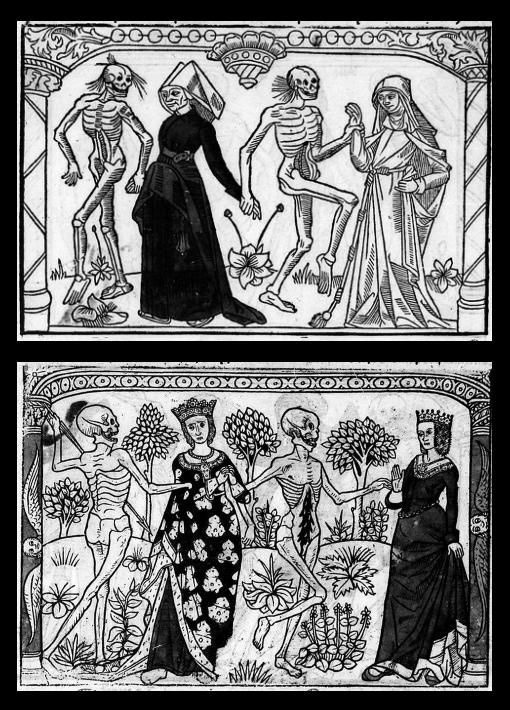
Another variant of this rhyme cited in Wilkie’s essay can be found in William Henderson’s 1866 book ‘Notes on the Folk-lore of the Northern Counties of England and the Borders’. While essentially the same, various linguistic differences can be distinguished, ranging from variations in spelling to entirely different words (the latter, of which, I have bolded.) As put in Henderson’s account:
“He mentions also that in the South of Scotland every person was supposed to be attended by a sprite, who had the power of taking away his life — a strange perversion of the doctrine of Guardian Angels. This is called by the old name of "Thrumpin," and is mentioned in these obscure verses : —
When the hullers o’ night are loosin’,
When the quakers are cramplin eerie;
When the moon is in the latter fa’,
When the owlets are scraughin drearie;
When the elleried are clumperin,
When the toweries hard are thrumping,
When the hawkie bird he kisses the yud,
Then, then’s the time for thrompin.
And gif ye miss the mystic hour,
When vengeful sprites are granted power,
To thrump ilk faithless wight;
The heavens will gloom like a wizard smile,
An’ the foremost will dim his carcase vile
Fra’ all uncannie sight.
For man and beast by the three stones light,
Hae little chance to thrive;
Till the sixty are past, and not till the last,
Can man and beast survive.”
Whether the result of legitimate nuances in translation, or the result of linguistic mistakes on the part of the author, certain differences in translation appear when I render this version into modern English using the same method as I did before. This amended translation reads:
‘When the mists of night are clearing,
When the poplars are eerily rustling,
When the moon is below the horizon,
When owlets are screeching drearily,
When the Elder trees are galumphing,
When the Powries* are loudly thumping,
When the bat kisses the old mare,
Then, it’s hour of the Thrumpin.
And even if you escape that mystic hour,
When vengeful sprites have the ability,
To push past each unreliable watchman,
The skies will darken like a Wizard’s Smile,
And the [corruption of the word for pole-cat] will hide his foul carcass,
From all uncanny sight.
For man and beast, under the light of Orion’s Belt,
Have little hope of prospering;
Until the hour is up, and not a minute sooner,
Will man or beast go on living.’
[**this may simply be a reference to the creature known as the Redcap—which has also been called the Powry—but it’s also quite likely that it specifically makes reference to a specific variant of the Dunter—a Redcap-like goblin which haunts old castles, towers, dungeons, and forts making ominous sounds.]
While it’s entirely plausible that the poetic lines above constitute a generalized construction of eerie presages, in order to serve as a spooky backdrop for discussion of the Thrumpin, it’s not the only way to look at it. Based on the content of these verses, one could posit that the occurrence and conjunction of omens, such as those sorts listed in the rhyme, portend the the death-by-Thrumpin of whomever should bare witness to them. And based on the context of the declarations in Wilkie’s essay, I further postulate that the these verses may describe a ‘countdown,’ of sorts, that begins upon the convergence of the aforementioned omens, and which marks the last hour of life afforded to a person by their Thrumpin, before the reaping.
With such scant evidence of the Thrumpin’s role in history and folklore left for us to scrutinize, these claims obviously represent conjecture. However, whatever the case may be, the memory of the Thrumpin and its station as Guardian Reaper lives on, in Scotland, and beyond. In fact, the 1994 play ‘The Skriker,’ by Caryl Curchill, even makes mention of them. In the play—which tells the story of an ancient faery who transforms into numerous forms throughout the story, as it pursues a pair of teenage mothers whom it aims to befriend, seduce and entrap—there is a scene that features a group of businessmen discussing their affairs in a meeting while, unbeknownst to them, their Thrumpins carry on a conversation of their own—presumably about the ways they intend to kill their mortal assignments.
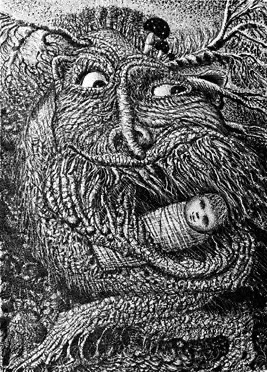
—
Sources:
‘Old Rites, Ceremonies, and Customs of the Inhabitants of the Southern Counties of Scotland’ by Thomas Wilkie (1789-1838)
‘History of the Berwickshire Naturalist Club, VOL. XXIII’ (1916)
‘Encyclopedia of Fairies: Hobgoblins, Brownies, Bogies, & Other Supernatural Creatures’ by Katharine M. Briggs (1976)
‘Notes on the Folk-Lore of the Northern Counties of England and the Borders’ by William Henderson (1866)
‘William Henderson’s Folk-Lore and Thomas Wilkie’s “Old Rites”: A comparative approach’ by J.B. Smith (2011)
‘The Skriker’ by Caryl Churchill (1994)
408 notes
·
View notes
Text
Liminal Spaces in Witchcraft
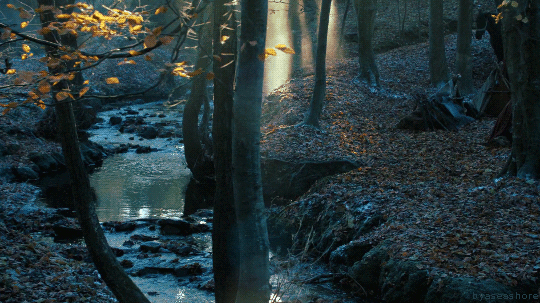
First of all, what is a liminal space? A liminal space refers to a place or time that is in a period of transition between two phases. These are usually places where reality feels altered because you are neither moving forward or backward, like a rest stop. The word liminal originates from the Latin word limens, meaning threshold. These places often give off a sense that time stands still and that you are experiencing some sort of reality shift.
In magic and witchcraft these spaces are considered to be the boundary between our world and the other, it is known as “the in-between”. These places are considered areas of great magic because it is believed this is where the veil is thin. These places are great for divination, spirit work, meditation and astral travel; they are ideal for hedge witchcraft.
Times & Spaces of Liminality:
crossroads manmade or natural
river, creek or lake shores/ beaches
hallway/corridor/stairwells/landings/doorways
graveyards
dawn, dusk, afternoon, midnight
valleys
forest glades
many more!
Samhain/Halloween is considered the best time to communicate with spirits and faeries because of its liminality, it is a time of transition between autumn and winter. Irish folklore tells that this is the day faeries and ghosts come out to play because of the veil thinning. The equinoxes and sabbats like Beltane and Imbolc are also days of liminality because the time of day and night are equal (equinoxes) or it is a transition between seasons.
Mental states of liminality are also times of spirit communication. While being in a meditative state we are in a state of transition between our concious and sub-concious minds, this is where we sometimes experience astral projection or messages from spirits. People often experience spirit while falling asleep because this is another state of liminality.
In my craft I often practice in liminality in order to connect with the faerie realms.
-Moonlight ���
12K notes
·
View notes
Text
The vampire of Highgate cemetery
Highgate cemetery was created in 1839, located in North London. It holds over 50,000 lost souls, I mean graves. Fun fact, one of the tombs belongs to Karl Marx, the guy who thought up Marxism. It also, allegedly, houses a vampire. These rumours began around this part of London, in the '60s, which was around the time some of the graves and tombs began to wither away. Maybe stirring what lays beneath? Also, witches are said to meet there and perform rituals, back in the day.
The first sighting of this bloodsucker was in 1963. Two girls spotted something lurking in the shadows while walking through the graveyard to go home. Wouldn't be my first choice of a way home. They saw a body rise from one of the tombs. Was it a vampire or had they just been smoking some of the babakoosh? They described the 'thing' as being 7 feet tall, wearing a long black coat and a black top hat.
Two weeks after this first, publicly known sighting, a couple saw a deathly face staring at them from the darkness near the iron gates. They said they felt compelled to continue staring at the face for several minutes. Damon Salvatore maybe? After the word got out about an unknown, horrific-looking thing haunting Highgate cemetery, many more witnesses came forward. People said they had seen shadowy and spectral figures, like a ghost, that would move between gravestones. Maybe it's the vampire, looking at the graves of it's once friends, that had passed many years ago? The newspaper began witting about these stories, warning the whole of North London that something was creeping around Highgate. Investigators visited this graveyard and came across lots of animal carcasses dotted around the area, drained of blood. Stefan Salvatore? That's another Vampire Diaries reference.
Eight years after the first few sightings of this strange 'thing' roaming Highgate, things began to turn physical. In 1971, a young girl was attacked by some sort of figure on Swain Lane- this is positioned next to Highgate cemetery. She was walking down this road in the early hours of the morning, heading home, when a tall, black figure with a "deathly" face, approached her. It appeared out of the icy morning fog and hit her. A motorist, driving down this lane, came to her assistance and scared the attacker away, back into the gloom. The young lady went to the police after this attack, she suffered from abrasions to her arms and legs. The police searched the area and noticed that, where this attack took place, 12-foot walls surrounded it. This means that the figure would have to climb over the 12-foot wall to climb away but this is near impossible for a human to jump over this, without assistance.
In another story, a man claims that he was hypnotised by something in the cemetery while he was visiting, during the night. Why was he hanging around the dead in the pitch black? He said he became disorientated and lost his way, while there. He felt like something was behind him, watching his every move from the bushes that surrounded this burial ground. When he looked over his shoulder to see what was following him, he said he was "hypnotised" by a black figure. He couldn't run, he was too scared, he was almost paralysed on spot.
Is this a local weirdo that stalks people at the cemetery, a ghost of someone buried there or is it a vampire that calls Highgate cemetery it's home? Many locals believed that it was a vampire that was following, attacking and paralysing these people and that it lived in one of the tombs. A popular theory was this vampire called Highgate graveyard's home because it is built on a ley line. Ley lines are lines, usually straight ones, that join two features in a landscape, which are thought to have been a prehistoric pathway or to have some sort of magical significance. David Farrant suggested in his book that this cemetery has power lines that create psychic energies, allowing vampires to manifest there. He also believed that the hub of power in the graveyard is at a large circle of tombs called 'The Circle of Lebanon' and it crosses through two nearby pubs- The Flask and Ye Old Gatehouse. If you're near, visit one of the pubs and see if you feel anything magical or supernatural there.
Highgate cemetery is prone to supernatural events. One story was that a man vanished one day, without a trace, while walking his dog through the gravesite. He had witnessed a figure before disappearing. In another story, a man had returned to his parked car, after visiting the graveyard and found a freshly dug up corpse, lying beside his car. That's a lovely surprise. Some say that an elderly woman is seen running frantically around the cemetery, looking for her children who she had murdered. Maybe she is a ghost that is trapped in a loop as punishment for what she did when she was living? Adding onto this list of spooky stories while you're strolling around this cemetery, you sometimes come across a man who simply stares into the ground but disappears as you approach him. Lastly, something with laminating eyes has been seen running in and out of the graves.
These are the stories of Highgate cemetery, where the dead lay to the rest. So, does this creature actually exist, is it just an old ‘Wives tale’ or is it a figment of one’s imagination?




30 notes
·
View notes
Text
What to Watch Out for in Your Neighborhood
The thick black smog that rises from the chimney of the old, derelict house two doors down. It has long since disappeared into ivy and overgrowth but you still hear them parading in and out in the dead of night. When you see the smoke and hear the songs, you know they are home. Do not approach at this time.
The jewels that hang from the branches of trees. Whether they are courting gifts, prisons, snares, or belong to the crows, it is best not to touch them.
The runes beneath your car; painted in blood and decorated with cherry blossoms. Perhaps you should take the bus today.
Sometimes the stars cluster above your house, leaving great, gaping, emptiness across the dark sky. You do not know what this means yet, but each time it happens one of your teeth falls out and have the strangest dreams.
The things in the nearby wood scream at night. Keep your curtains drawn, even as you hear them approaching from up the street, the creak of their limbs and the croak of their voices crying out. Keep silent and in the morning scrub their handprints from the window.
There are deep cracks in the sidewalks through which the strangest flowers have started appearing. You feel drawn to them; they are calling out to you, don’t you hear? Come, pluck one from its stem, consummate the pact.
There are women veiled in gold, sometime grouped in the centre of the street. Allow them to stay in your home and listen at the door of your guest room as they whisper sweetly to you, but do not go in. They will come to you in your dreams and it is here they will repay your kindness. Do not be concerned about the figures seared into your skin upon awakening.
There are times when gods will fill the skies above the rows of houses, raging and manic in their divinity, their numbers so great that they block out the sun. Secure a blindfold over your eyes if you must go out, and do not be tempted by their blessings.
There are strange, strange, goings on in your neighborhood and I wonder if it is, in some small part, to do with you.
641 notes
·
View notes
Text
The world's oldest story? Astronomers say global myths about 'seven sisters' stars may reach back 100,000 years https://phys.org/news/2020-12-world-oldest-story-astronomers-global.html
Holy shit, this is cool!
So many cultures call the Pleiades some variation of the "seven sisters" despite only having six visible stars. There only appear to be six because two of the stars are so close together as to appear as one.
The myths also mention one sister leaving or hiding to explain why there's only six. And based off observations and measurements, those two that are so close together used to be visibly separate. One literally has moved to hide.
And based off the similarities between the more commonly known Greek myth and the Aboriginal Australian myth, plus some other stuff, this myth could possibly even date back to when humanity still all resided in Africa!
67K notes
·
View notes
Text
One time, in real life, at grocery shopping, I wasn’t really listening and thought the cashier asked if I wanted the receipt (as usual), and I, friendly smiling, just replied “no thanks”. But then he stared at me really strange, and I realized he had not just asked something, but had said: “have a nice evening”. To which I eventually with what turned out to be a creepy smile had replied “no thanks”.

5K notes
·
View notes
Photo
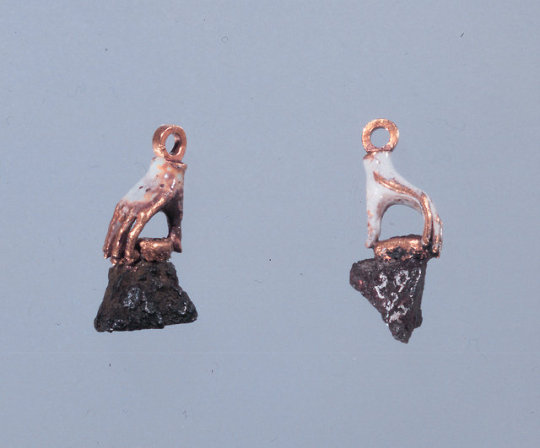
These enamel earrings in the shape of hands hold pieces of shrapnel removed from the eye and forehead of Denmark’s King Christian IV after he was wounded in battle. He gave the earrings to his mistress.
64K notes
·
View notes
Text
Favorite Danish folklore I grew up with
Lygtemænd (the lantern men): Like will-o’-the-wisp, jack o’lantern and similar… Nobody really knows who or what they are. They are small creatures with lights (probably lanterns) that are moving around in marshes and swampy fields at night. Never follow them. If you follow them, you’ll never be seen again. They will probably lead you further out into the marshes where you drown. Don’t even look at them, because you may get the urge to follow the light. If you’re lost, you can however pay them (by leaving money at the roadside) to lead you back home - if you’re brave enough.
Åmanden (the river man): He lives in the rivers and lakes, and prevents overflow and floods, but needs an annual human sacrifice (aka drowned people) in return. He looks like a very beautiful young man, but has sharp teeth. If he hasn’t got his sacrifice, he will lure people into the river. He can sound like a crying baby, to make you go search for an abandoned baby near the river, or he plays the violin so beautifully that you will follow the sound into the water, where he will drown you. Never go near a river at night or dawn!
Helhesten (the hell horse): So the first soul buried on a new grave yard will resurrect and haunt the grave yard. Because of this, the first soul buried was often not a person but a living animal, most often a horse. The hellhorse has three legs, sometimes it’s beheaded, and it brings people illness and death. When you see it, you will die. If you hear a horse neigh or stomp on a grave yard, don’t look up! Never! Never go to a graveyard at night.
De underjordiske (the underground people): basically small trolls. They live on the island Bornholm in mounds, hills, cliffs or big rocks. They are small creatures, very smart and have an almost human-like farmer lifestyle. They are usually friendly and peaceful, but may be troublesome, if you dig in their mound or e.g. let your animals walk around on their home. They can also kidnap, or switch your baby out with one of their people and make him look like the baby. The new baby will become more and more ugly, stop growing, never learn to speak and eat A LOT. The only way to expose it is to tell it something so stupid and ridiculous that it gets flabbergasted. If you visit the island ask a local - almost everyone knows somebody that met the underjordiske or had an encounter themselves.
Nisser: kind of small household gods. They are little dwarf-like creatures that live hidden in your house, typically on the loft or in the stables, if you have a farm. Usually they are helpful and some sort of nice warden, but if you treat them bad, they may trouble you. You should leave a bowl of rice pudding for them on the loft, especially at Christmas. Some may also have be humorous and hide your stuff, so you think you replaced it, then they are called Drillenisse (mocking nisse).
Elverfolket (elves): They live in forests, glades and mounds and are known for their beauty and their feasts. The very beautiful elver women will typically dance around their mound looking outwards in misty nights, so you can see their beauty, but in their bag they are hollow like an old tree trunk. If you join their dance and feast, they will never let you go. Stay away from them and from their mounds and they will be peaceful. Their king is very powerful, but if you’re respectful and keep the elverfolks homes safe, he may in return bless your land.
Mosekonen (the marsh witch): She is an troll-like woman who lives in a hidden cabin in the marshes. She is known for brewing something in a big kettle, but nobody really knows what. Probably a special brew for their party’s (e.g. for Walpurgis Night). You will know that she is brewing, when there is fog and mist over the marshes. She gets help from the Lygtemænd with her fire, so you shouldn’t go out there to find her, as you may drown.
Havfolk/ nøkker (sea people): Human like creatures (like mermaids) that live in the sea and might have fish-like features like a fish tail. The women are very beautiful, sing very lovely, and may lure men into the water and (not necessarily willful) drown them as they take them into their underwater home. The havfolk may come out of the water and look human, but they will always be wet. The men can transform into a big black or white horse that comes out of the sea at night and rushes along the beach. They may lure you to climb and ride, but will then ride directly into the sea and drown you. Stay away from the sea at night to be safe, and if you hear someone singing at the sea, quickly cover your ears with your hands!
611 notes
·
View notes
Text
A quick introduction to Vætter
Disclaimer: I’m Danish and my sources are primarily Danish, so this is very Denmark-centric. Please add your Norwegian/Swedish/Faroese/Finnish/Icelandic corrections, additions, and specificities if you have any!
Norse elves, trolls, ghosts, and other supernatural/nonhuman people are not fae. Instead they comprise their own class of beings called the vætter or vættir (singular vætte or vættr). Danish synonyms to vætter include De Underjordiske (the ones from beneath), De Overjordiske (the ones from above), bjergfolk (mountain people), højfolk (hill people), troldtøj (trollkind), gespenst (ghost, German loan-word), utyske (dangerous beast, derogatory), troldpak (troll-scum, deragatory), and runepak (rune-scum, derogatory).
There are many specific, named subgroups of vætter (the aforementioned elves, trolls, and ghosts included), but not all vætter belong to one of these subgroups. It’s not uncommon for stories to refer to wildly different entities as simply ‘vætter’. Examples of these undefined vætter include tiny blue lights living under the fireplace (C. Brockdorff; Kristensen), spirits sneaking into the house at night to suckle the childrens’ thumbs (C. M. Larsen; Kristensen), and a very very strong rooster (Chr. Rasmussen; Kristensen).
Vætter are usually smaller than humans, though giants do show up in folklore, trolls can be as big as houses, and one notable bird (Gammen or Fugl Dam) is large enough to carry an ox in its talon. But due to their primarily short stature, another somewhat derogatory word for vætte is ‘pusling’ which roughly translates to toddler or tiny person. The stories about gargantuan vætter are rare, and the individuals in these stories are usually directly named.
The line between human and vætte isn’t always clear. A human can give birth to a vætte (like a mare/hag), a vætte can be turned into a human (like a werewolf), and humans and vætter can be raised among either kind and live long healthy lives (like in many stories of changelings). Vætter can be alive, dead (like mylingar), or something in-between (like gravsøer).
Vætter are usually tied to the land somehow. Nisser are tied to their farm, trolls are tied to their hills, and mermaids are tied to their underwater houses. You’ll only rarely find stories of vætter travelling more than a kilometer or two away from their home, and you just plain won’t find stories of vætter out of their element. There are no stories of nisser in the wilderness or of trolls sailing. Vætter often serve as guardians or lesser gods of their land, and it was customary to treat the vætter around you like neighbors or even family members up until around 200 years ago.
57 notes
·
View notes
Text
open a new window somewhere in the world.
177K notes
·
View notes
